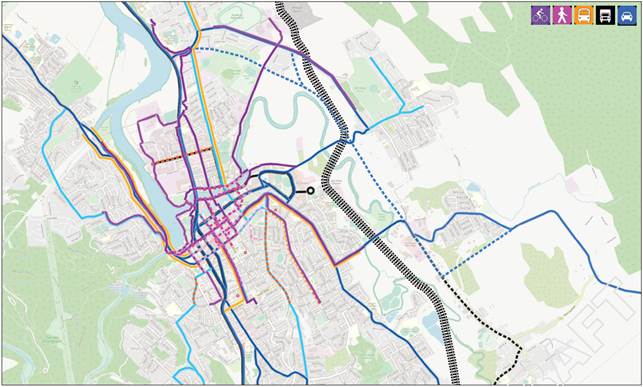Launceston Network Operation – Preliminary Framework
Overview
The Launceston Network Operating Framework (NOF) is a first step in the Network Operation Planning process. Subsequent steps will soon commence, including consideration of what data will be required to inform the eventual NOP and the associated measures and analysis.
Its development was generally based on the guidelines set out in Austroads Network Operation Planning Framework and Guide to Traffic Management Part 4: Network Management Strategies. It also incorporated ideas and information captured in the modal network development workshops run over two days in Launceston. The framework has been found beneficial in setting an agreed aspirational network arrangement, as shown below, and is being referenced for small-scale operation decision making (not a definitive source as yet) as part of projects and signal operations.
Launceston NOF- Modal Network Priorities

Source: Launceston Network Operations - Preliminary Framework, by GHD for Department of State Growth Tasmania, November 2019
Key Findings
A write-up of the NOF material and interview discussions is provided below.
Theme | Response |
|---|---|
How is "network operation planning" defined and what should it be used for |
|
The development processes / steps / stages and timings |
|
Where it fits in the overall network development and management process |
|
How it aligns / integrates with approval and funding processes | Support transport investments and investment decisions. May inform future large-scale infrastructure investments e.g. considering the need for a New Tamar River Crossing and / or upgrade of Charles St Bridge. |
How it aligns / integrates with network and project planning approaches | Workshops were held to:
|
What the strategic objectives are and where did they come from | The objectives were identified in the workshop and defined as:
The objectives also relate to planning strategies including the Greater Launceston Plan, Greater Launceston Metropolitan Passenger Transport Plan and City Deal. However, it was noted that an overarching transport vision set before or through the NOF would have been beneficial. The City of Launceston did develop a vision through a transport strategy, which is awaiting member approval, but this occurred at the same time as the NOF development. |
What the performance indicators are and where they come from | To be completed, but noted as follows:
|
Who the development team members should be |
|
Who should implement NOPs |
|
How should it be implemented | A periodic review of the NOP is expected, but timing is unknown at this stage |
What modes have been considered |
|
What network typologies and settings are relevant |
|
Engagement recommendations | The process began with two workshops to produce the framework with the following stakeholders:
|
Planning and Assessment tools and modelling approaches | At this stage, it is unclear whether or not the Network Fit Assessment tool will be used. It will be dependent on the alignment or performance measures for the Launceston NOP and Hobart NOP that is currently in development. |
Required input evidence and data |
|
Monitoring, feedback, update, etc. processes | Not provided |
The Tasmanian State Government is now working closely with the City of Hobart on a Network Operating Plan for Hobart. This will build on the previous Launceston NOF work. There have been some key learnings and amendments to the approach, principally the following:
- Greater consideration of land use, with transport being an enabler of land use and activity.
- A Transport Vision has been established beforehand. This will help provide an agreed aspiration for the NOP / NOF to align with.
- Greater input from the operation traffic signals team, and intent to use this as soon as possible to inform traffic management arrangements.
- More proactive engagement and briefing of Council and State members, and Minister as part of the process.
It is anticipated the Hobart NOP will be reviewed after 5 years and revised if necessary.
Documents
The documentation provided as part of this case study included the following:
- Launceston Network Operations - Preliminary Framework, by GHD for Department of State Growth Tasmania, November 2019
